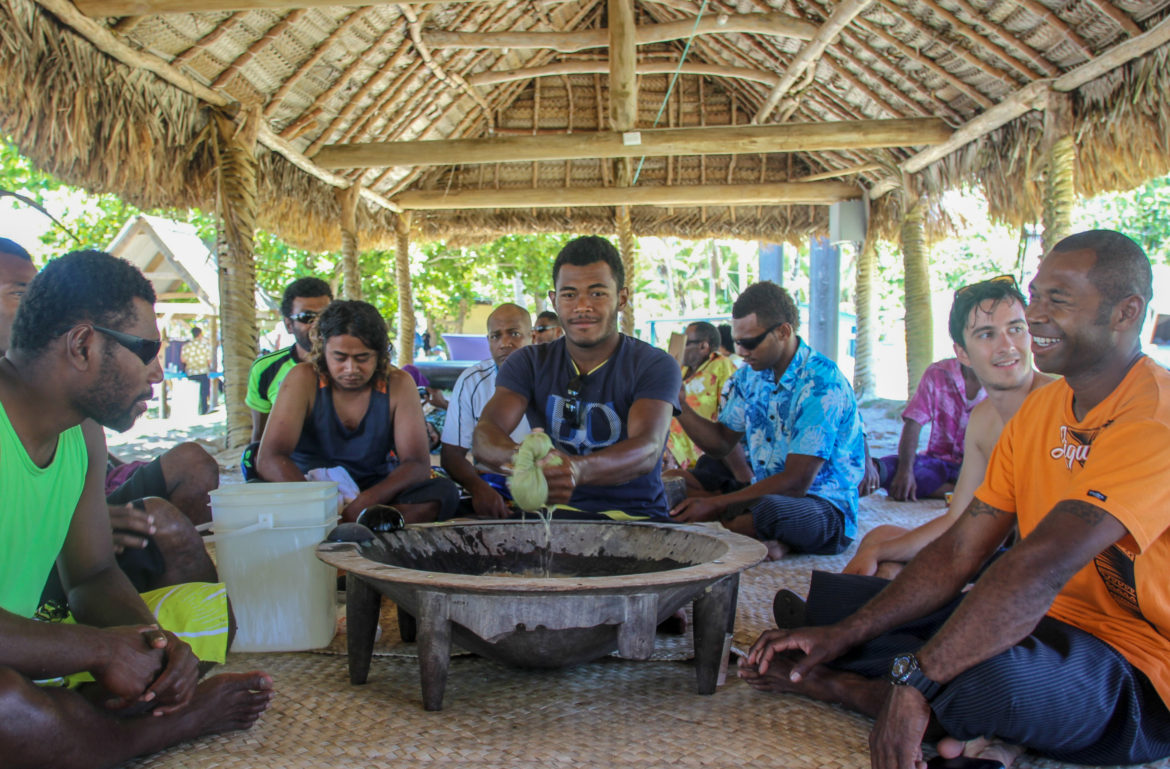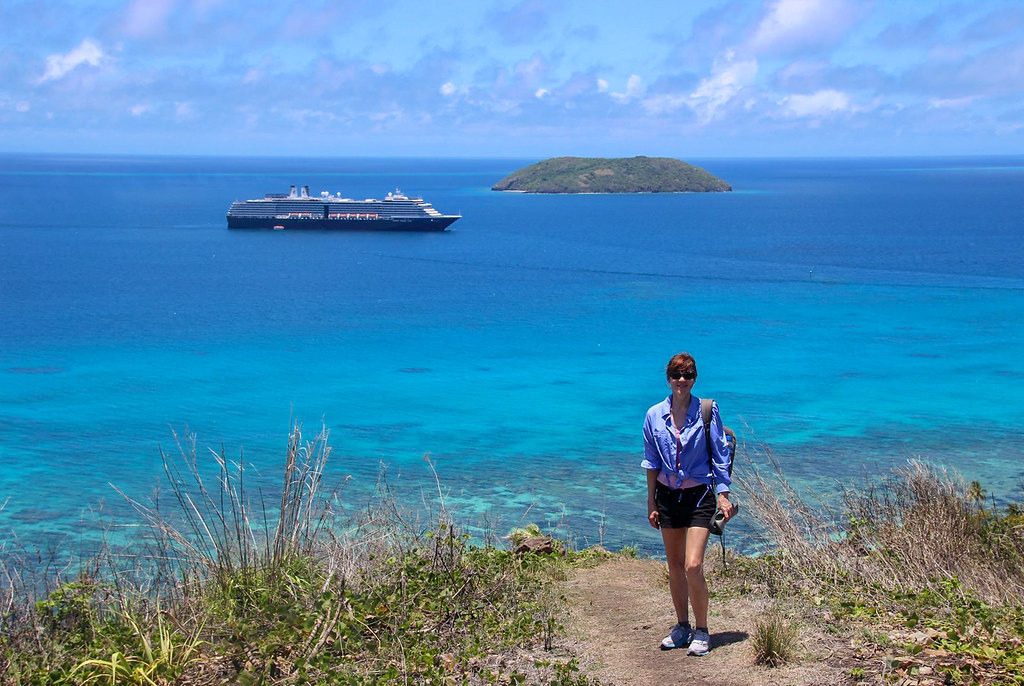Doing a Fiji Kava Ceremony should be on everyone’s Bucket List. I got the opportunity when visiting the exotic Dravuni Island. Kava is an herbal medicine to drink during a traditional South Pacific Kava Ceremony. You can buy it as a supplement to calm stress & anxiety. However, I believe the communal connection in the South Pacific winds enhances Kava’s healing effects. Read on to learn about my experience and the health benefits of Kava.
Kava Health Benefits
The herb, Kava kava (Piper methysticum) is a member of the pepper family, indigenous to the South Pacific. This tropical shrub contains psychotropic constituents called kava lactones found mainly in its roots and rhizomes. Kava has 4 significant medicinal properties:

1. Anti-anxiety
2. Anti-spasmodic
3. Diuretic
4. Improves appetite and digestion
Soon after drinking kava, there is a numbing effect on the tongue and mouth area. It’s a bit like anesthesia effects from a dental visit. Similarly, it gradually wears off over time. Taken moderately, there are no harmful side effects. However, if overused daily, it can decrease motivation, strength and leave a scaly rash. These side effects have shown to stop once kava is no longer taken.
Overall, it is not habit forming. Kava is available in South Pacific markets (shown above) as a root and powder. Its lactones are insoluble in water and destroyed by heat. Therefore, it should be first powdered and then infused in only cold water for a few minutes. It’s squeezed through a cloth to release its lactones from the root fiber.

Fiji’s Dravuni Island Hike
& Kava Ceremony
Fiji is an archipelago of 330 islands (almost a third have permanent residents). One of my most memorable stops as an Acupuncturist-at-Sea on a cruise ship was on the pristine Dravuni Island, home to 125 Fiji natives. It’s the most northern of several islands within the Great Astrolabe Reef. Just north of the Astrolabe lies Solo Reef.
This atoll, according to legend, was a village that sunk into the sea. I explored 5 hours on this volcanic island and planned to make the hike to the top of Mt. Dravuni (130 feet or 40 meters) as my destination for the day. But as the ole adage goes, it’s about the journey, not the destination.
Hike to the Island’s Highest Point

Upon arrival, I immediately step into “Island Time.” I am on my own and feel completely free to explore this paradisiacal island, surrounded by sparkling turquoise waters while feeling the warm, tropical breeze blowing away my stress. I walk by the little village and intend to check in with the locals after my exploration.
The hike is just the right amount of challenge without being too hard, as I make my way up to the highpoint of the island about 131 feet (40 meters) above sea level. I cross paths with a musician from the ship and we hang out, taking amazing photos of each other, amongst the 360-degree panoramic view of infinite blue from the water and cloudless sky.
The island is small enough to see the entire shoreline from the high vantage point, as well as the beautiful coral reef sparkling offshore. The ethereal blues, greens, and turquoise all around me, feel like stepping into a painting, almost too colorful to be real. I refreshingly inhale the view and wander for a good hour before coming back to earth on my way down to the only village on Dravuni Island.
The Fiji Kava Ceremony
As I approach the village, I intriguingly notice a thatched hut with no walls, for the breeze to refresh a group of about 15 people sitting cross-legged on the ground. Half of them appear to be male, native Fijians along with the other half as tourists. Noticing a large bowl in the center, I happily realize what this is, as someone invites me to join the Kava Ceremony.
I am elated because I’ve wanted to partake in a Kava Ceremony for years. I’d been nervous about doing it due to my concerns about the water, having heard from others who got sick from the Fiji water (not the kava). However, I could not resist the perfect timing and inviting nature of all the people amongst this quintessential setting.

I sit down and relax immediately, as the group has a nice harmony and mutual intention for an amazing Kava ceremony. I watch as the young man prepares the Kava in the large wooden bowl (left photo) called a Tanoa. The kava powder is wrapped in a cloth, with his bare hands stirring it in the bowl of water. Being in a health profession, I cringe under my breath about his bare hands in the water, hoping he washed them beforehand (pun intended). However, I soon overlook it and just take in the vibe and excitedly wait for my first taste of kava.
Fiji Kava Ceremony Ritual-“Bula!”
Once the kava is prepared, the host fills a small bowl, called a bilo (made from half a coconut shell) and hands it to a young Fiji man. Before he takes the bowl, he claps his hands once and says, “Bula!” (normally a greeting, but in this setting it’s an expression of gratitude) Then, he takes the bowl with both hands and drinks it all at once. With a grin, he lets out a big sigh of happiness and hands the bowl back to the host and then claps (along with everyone else) 3 times, saying, “Bula!”
I am completely surprised at all this, as I had no expectations going into the ritual behind the Kava Ceremony. This pattern continues over and over again, for each individual person in the ceremony. I love that it’s such an empathic ceremony, in that everyone gets a chance to share the experience with each person as s/he completes the ritual one by one.
My Kava Experience

Because of my seat location, I am almost last to be served and drink the Kava. I excitedly clap my hands and say, “Bula!” and gulp it down fast, like I am downing a shot. The taste is almost like gritty dirt; I attempt to hide any expression of distaste, and just focus on the effects.
Almost immediately, I feel my tongue, mouth and lips beginning to tingle and go a bit numb. The relaxing wave undulates through me just like the smooth ocean waves around us, as I relax into this extrasensory moment. I stay for the second round and repeat it all over again, ending with a second bowl of Kava that takes me to the crest of the experience, to just be at one with the ceremony and lovely group.
Surrendering, I ride the magical wave of relaxation from Kava, taking me back to the ship. I will always cherish my experience among the south pacific winds, blending us into a natural harmony of waves, reef, island, sun and kava for a deep soul healing and sojourn.
Read More!
An Exotic Tivua Island, Fiji Day Trip – Snorkeling, Swimming & Relaxing
Magical Vanuatu’s Efate Island Travel – Blue Lagoons, Beaches & Waterfalls


